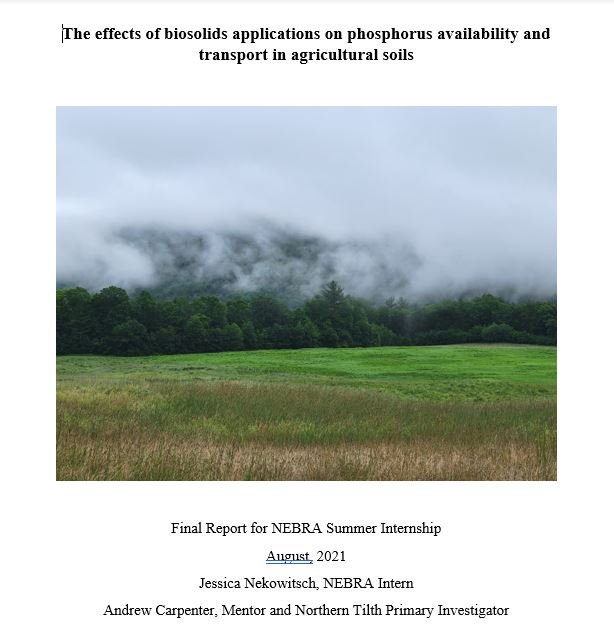10/22/21
Summer Intern Completes Project for NEBRA Research Committee
Jessica Nekowitsch is going into her senior year in the environmental engineering program at the University of New Hampshire. She spent this summer working for NEBRA on a project developed by the Research Committee to study the effects of biosolids applications on phosphorus availability and transport in agricultural soils. The study focused on two New England farms, one in New Hampshire and one in Vermont, where Class B biosolids have been land applied for 10+ years. Jessica conducted an extensive literature review and dug into the soil data and records maintained by the farms and the treatment facilities supplying the biosolids. She also got out in the field to sample the soil at the farms in the study, learning a lot about biosolids in the process.
Jessica’s final report is on NEBRA’s Research Committee webpage: Research Committee — NEBRA (nebiosolids.org) as well as a short presentation she recorded for the Northeast Residuals and Biosolids Conference on October 7th. Her major finding was that the iron and aluminum from common coagulants used by Water Resource Recovery Facilities (WRRFs), which end up in the biosolids, can significantly reduce phosphorus run-off versus other commercial fertilizers and manure.
Data from two long-term land application sites indicated that plant-available and water-soluble phosphorus did not increase as much as the calculated excess in total phosphorus applied to the fields would have suggested. In other words, there is less over-application of phosphorus than accounted for using the current methods to determine land application rates. Jessica’s report points to research she found confirming that biosolids applications with added iron and aluminum salts caused lower than expected increases in labile phosphorus, which suggests that the some of the phosphorus was bound to these metals. Labile phosphorus is that portion of the total phosphorus considered to be mobile and water soluble, thus the most likely to be transported offsite to adjacent surface waters via storm water runoff.
Research Committee Chair Tracy Chouinard is pleased with the success of the student intern program with lots of benefits to NEBRA and Jessica. She is looking forward to continuing the program and improving those connections between NEBRA and local university researchers and their students. “We had a long list of ideas for research projects that would answer important questions we still have – especially around biosolids and residuals as soil amendments, which is the most sustainable end use for these ‘waste’ products,” Tracy told NEBRAMail.
Thanks to all the Research Committee members and the organizations who provided funding and support for the project including Essex Junction Vermont Water Resource Recovery Facility, LP Consulting, and Northern Tilth. Special thanks to Andrew Carpenter from Northern Tilth who served as Jessica’s mentor and guided her research efforts. A future research topic suggested by one of the farmers involved in this project is to take a closer look at setbacks and better determine how wide a buffer needs to be to protect surface and ground water.
UNH Student, and NEBRA summer intern, Jessica Nekowitsch


